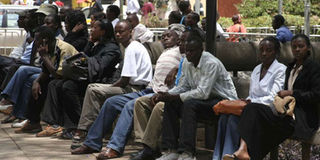Include young people in decision making

Jobless youth seat outside Hilton Hotel in Nairobi. As a county, we must address the issue of politically driven youth policies that have no tangible outcomes. FILE PHOTO | NATION MEDIA GROUP
What you need to know:
- Social Network Analysis answers the question to what extent the youth are involved in policy decisions.
- The more youth feel they can make their voices heard, the greater trust and legitimacy of policies.
The youth are an important subsystem of any country in the world and Kenya is no exception.
As a county, we must address the issue of politically driven youth policies that have no tangible outcomes.
Young people must be encouraged to have greater participation in decision making to ensure public service delivery meets their specific needs.
POLICY DECISIONS
This is where Social Network Analysis comes into play.
Networks are a powerful tool that explain the social realities today.
They range from citizen networks, corporate networks, gamer networks, terrorist networks to learning networks.
Social networking has changed the way the youth live, socialise and share.
Social Network Analysis answers the question to what extent the youth are involved in policy decisions.
This inclusion can only happen if we define the specific role young people play, understand the nature of interaction and identify bottlenecks that hinder them from taking their space in the decision table.
IMPLEMENTATION
In terms of implementing youth programmes in Kenya, there are a number of social processes that are necessary.
Some relate directly to social networks. Social Network Analysis is conducted by recording data on who is connected to whom.
These relations can be mapped through things like who is friends with whom, or archival traces such as e-mail exchanges, joint purchasing behaviour, joint authorship behaviour, or GPS co-location information, to name but a few.
The network data are used to derive individual network connections such as the number of links each individual has, and network level measures such as network density, a count of the number of links present expressed as a proportion of all links possible.
Programmes that meet high standards for rigorous designs, impact, and replicability in effectiveness trials can earn the label “evidence-based” and be adopted for large-scale implementation.
OPEN-MINDED
This Social Network Analysis concept cannot be complete without talking about structural holes.
Policy makers must be aware of networks in which people can broker connections between otherwise disconnected segments.
Obviously, this becomes a discussion of brokerage opportunities that can lead to control of information diffusion.
Holes in social structure create a competitive advantage for an individual whose relationships span holes as opposed to network closure.
Such individuals are self-centred and may not have the interest of the youth at heart.
The process of mapping networks, and feeding back the results to the network members has the potential to facilitate decentralised planning so as to reach youth at grassroots level and have their voices represented on the table.
The more youth feel they can make their voices heard, the greater trust and legitimacy of policies.
This will ultimately strengthen and increase their trust in formal institutions serving their interests.
Dr Kellen Kiambati is a management consultant with wide experience spanning over eight years.
Lecturer, KaRU. [email protected]. Dr Anne Kariuki is a social scientist and a management consultant. Lecturer, KaRU. [email protected]




